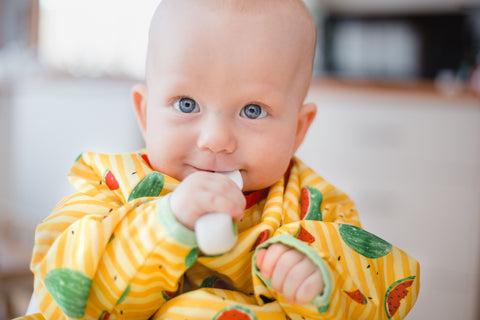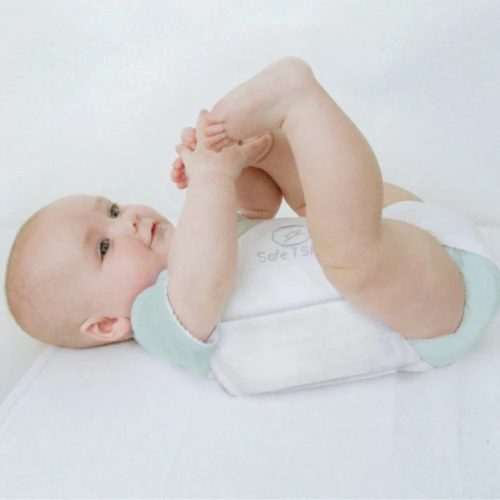Heard of baby led weaning but are not too sure if it is right for your bubs? Check out this handy guide which contains the info you’ll need to get bubs onto solids successfully.
Baby led weaning has become a popular tool for parents when it comes to introducing solids to their babies. Rather than the parents spoon feeding them, the baby learns how to control the feeding themselves. In this way, they gain control over the quantity of what they eat and how they eat it. The other big difference is that rather than being provided with pureed food, the food is instead cut into small pieces instead.
But it’s not all clear sailing and before you head into baby led weaning, it’s important that you gain an understanding of both sides of the picture.
Taking a Look at Baby Led Weaning
From the time a baby is around six months of age, solids are beginning to be introduced. Traditionally this has meant baby rice, pureed vegetables, fruit and a bit of meat. Plunket recommends that one new food is started at a time, with one or two teaspoons fed at a meal, while breastmilk or formula remains the most important food at six months of age.
We were unable to find any information on the Plunket website about baby led weaning, though they do suggest providing finger food at around eight or nine months of age. The Ministry of Health and some healthcare professionals have raised concerns that baby led weaning may increase choking risks and could result in poorer nutrition. We recommend that before you begin any baby led weaning, you discuss your thoughts with your Plunket nurse or GP.
Advocates of baby led weaning (BLW) believe that a baby should receive the same or similar foods to what the family are eating at meals. They believe that BLW:
- Gives control to the baby of what they want to eat and how they want to eat it
- Encourages hand eye coordination
- Matches the developmental milestones, letting a baby begin eating in their own time
- Develops a baby’s fullness signals, resulting in less overeating and health related issues
- Lets babies be drawn to the foods that contain the nutrients their body needs
Let’s move onto the cues which can demonstrate a baby is ready for BLW.
How Do I Know if My Baby is Ready for Baby Led Weaning?
Just like with traditional spoon feeding, it is important that you identify the cues your baby makes that show they are ready to begin solids. These include:
- Being able to sit unsupported in a highchair or on a lap
- Interested in watching others eat
- Tracking the food you eat from your plate to your mouth
- Wanting to drink more milk and not being as full after drinking
- Able to move food from the front of their tongue to the back and swallow it
- Reaching for food
Then when you do begin, think of the first few meals as more of a play and experiment time, rather than a meal. You’ll find your baby will do a lot of touching of the food, feeling its texture, sucking on pieces of food and moving it around. Yes, they’ll be plenty of mess to contend with, which can be mitigated by having a large drop cloth under their highchair and using a Bibado Highchair Coverall Bib. Over time, the quantity of food your baby actually consumes will grow, but don’t be surprised if they don’t eat anything for the first few days or weeks. If you find this happens, get in touch with your Plunket nurse for their suggestions.
Foods to Try When Baby Led Weaning
The same food rules apply when baby led weaning as to spoon feeding. Food should be free from salt and sugar and be as healthy as you can make it. If there is sauce on the food, wash it off before giving it to your baby.
In terms of shapes, aim for long rectangular shapes which are easy for little fists to pick up. Having a ‘handle’ on the food piece is ideal, such as a piece of broccoli has. Avoid foods that can led to chocking because of their shapes, such as nuts, grapes and cherry tomatoes.
Some of the best early BLW foods include:
- Soft fruits such as banana and kiwifruit
- Cooked pumpkin or carrot
- Cooked mince
- Cooked broccoli and cauliflower
- Penne pasta
- Toast
- Homemade pizza
Once the early stages of BLW and the risk of choking has decreased, you can move onto sliced grapes and tomatoes, raw apple, peas and carrot. You could also make mini muffins, slices, rissoles and rusks for them to eat too.
Making Things Easy When Baby Led Weaning
As mentioned earlier, BLW can get very messy! But it can also be a challenging skill for bubs to learn to feed themselves too. This can lead to frustration and a full-on refusal to even attempt to try to eat. By providing the right baby tools, such as bowls, trays and cutlery, you can help make this an easier time. We suggest considering using the following:
- Doddl Cutlery Set – at first bubs will want to use their hands to pick up the food and bring it to their mouth. But it is important to have cutlery available for them to experiment with too, even if it is just sucking and chewing on it. Later on, you can put food onto the spoon and fork for them to bring to their mouth themselves.

- Easymat Suction Plate – they’ll pick up pieces of food and throw them, but this handy placemat will remain stuck to their tray or on the table!

- Tri-Suction Bowls, Silicone Suction Plate – once again you can foil their plan to throw their entire lunch on the ground. These handy bowls remain attached to the table top or highchair tray making self feeding easier.
![]()
- Pulp Silicone Feeder – a great little feeder for snack times, it makes it easy to try a variety of foods for bubs.
- Bibado Highchair Coverall Bib with Sleeves – food will go everywhere, but at least you can keep their clothes clean with this brilliant coverall bib!

If you haven’t already, come join ourSleepytot Parents Support Group on Facebook. It has plenty of experienced parent members who’ve already been where you are now and are more than happy to share their experiences and advice with you. Or for more food and eating related advice for baby, be sure to check out our ever growing online article resources.





Leave a comment (all fields required)